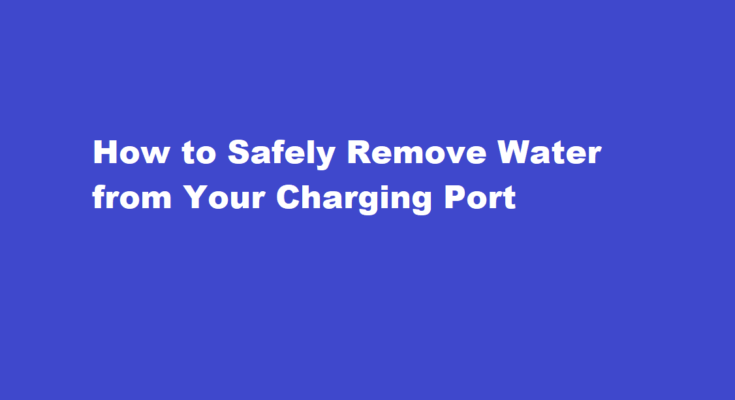Introduction
Our smartphones have become an integral part of our daily lives, serving as communication devices, entertainment hubs, and productivity tools. However, accidents happen, and one common mishap is getting water into the charging port. When this occurs, it can disrupt your device’s functionality and even lead to permanent damage if not handled correctly. In this article, we will guide you through the steps to safely and effectively remove water from your charging port.
Act Quickly
Time is of the essence when water enters your charging port. The longer it remains there, the greater the risk of corrosion and damage to the internal components. The first and most crucial step is to power off your device immediately. This prevents any electrical shorts and minimises the chance of further damage.
Disconnect All Accessories
If you have any accessories, such as headphones or chargers, connected to your device, remove them. This will help avoid water spreading to other parts of your device.
Remove the Water
There are several methods you can use to remove the water from your charging port
- Shake It Hold your device with the charging port facing down and gently shake it to encourage the water to drip out.
- Blow Dry Use a can of compressed air or a hairdryer on the lowest, cool setting to blow air into the charging port. This helps in evaporating the water droplets. Ensure you hold the device at a safe distance to avoid overheating.
- Vacuum Cleaner Some vacuum cleaners have small attachments that can be used to suck out the water from the port. Make sure the device is off before attempting this method.
Absorb Excess Moisture
To ensure that all the water is removed, you can use absorbent materials like rice or silica gel packets. Place your device in a bowl filled with these materials and leave it overnight. The rice or silica gel will help draw out any remaining moisture.
Avoid Heat Sources
While it’s tempting to use heat to expedite the drying process, it’s essential to avoid exposing your device to excessive heat, as this can damage internal components. Stick to room temperature drying methods like the rice or silica gel mentioned earlier.
Test Your Device
After allowing your device to dry for at least 24 hours, it’s time to check if it’s working properly. Plug it into a charger and see if it charges. If it does, you’re in luck, and your device likely survived the water encounter. However, if it still doesn’t work, you may need to seek professional help.
Seek Professional Assistance
If your device remains unresponsive or exhibits unusual behaviour after following the above steps, it’s advisable to consult a professional technician or contact the manufacturer’s customer support for guidance. Attempting to disassemble your device or repair it yourself at this stage may cause more harm than good.
Preventative Measures
While it’s important to know how to address a water-in-charging-port situation, taking preventative measures is equally crucial
- Use Waterproof Cases Invest in a waterproof or water-resistant case to protect your device from accidental exposure to water.
- Avoid Water Exposure Be cautious when using your device near water bodies, in the rain, or in humid conditions. Keep it away from sinks, pools, and open drinks.
- Close Ports and Covers Ensure that all port covers and flaps are securely closed when not in use, especially in dusty or wet environments.
- Use Wireless Charging Consider using wireless charging methods to reduce the need to plug and unplug cables frequently.
FREQUENTLY ASKED QUESTIONS
How do I get liquid out of my charging port?
Turn off your phone immediately and dry it off with a lint-free cloth. Allow the charging port to air dry in a well-ventilated area for at least 5 hours. To get excess water out of your phone, gently tap it against your hand with the charging port facing down, so water can drip out.
Will water come out of the charging port?
The best way to get water out of a charging port is to just wait and let it dry. You can also try to knock the water out by tapping the device against your hand, with the charging port facing down.
Conclusion
Getting water in your charging port can be a frustrating and potentially damaging experience, but by following the steps outlined in this article and taking preventative measures, you can increase your chances of a successful recovery. Remember, acting quickly and carefully is key, and when in doubt, seek professional assistance to avoid further damage to your valuable device.
Read Also : Restarting Your Chromebook A Quick and Easy Guide



